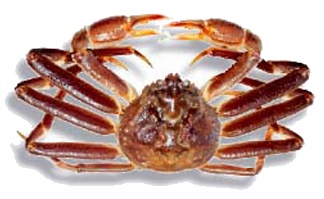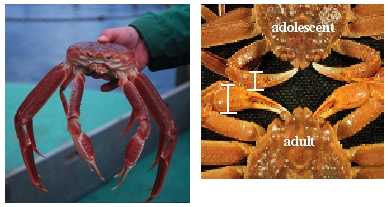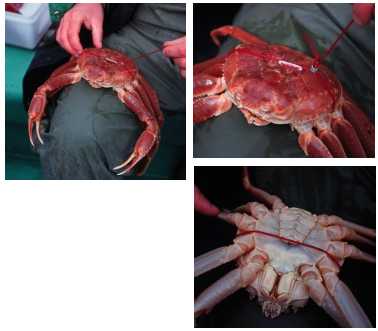
|
Tagging Studies Special Issue 1999 |
Crabwise - Tagging Studies - Special Issue 1999


Table of Contents
- Snow Crab Tagging Projects
- Area 19: 1993
- Area 21/22: 1994
- Experimental Area 12/F: 1996
- Area 12/Dumping ground: 1997
- Area 12/Irving Whale Site: 1997
- Area 19: 1998
- Fishermen's experiments: 1996-1997
- Tagging methods and materials
- Making a plea for cooperation!
- Why bother?
- How to Reach Us
1993 - 1999 Snow Crab Tagging Projects
(by: Offshore Crab Fisheries Section, Science, Moncton)
| Year | Location / Title | # of crabs | # of returns |
|---|---|---|---|
| 1993 | Area 19 | 558 | 66 |
| 1994 | Areas 21-22 | 870 | 182 |
| 1996 | Area 12 / F | 745 | 291 |
| 1996 | Areas 23, 24 / Fisherman's Projects | (250) | 21 |
| 1997 | Area 12 / Dumping ground | 400 | 80 |
| 1997 | Area 12 / Irving Whale | 329 | 21 |
| 1997 | Areas 20, 21, 22 / Fisherman's Projects | (250) | 7 |
| 1998 | Area 19 | 595 | 26 |
| 1998 | Area 24 / Chedabucto Bay | 247 | none |
| 1999 | Areas 23, 24 | 500 | none |
| 1999 | Area 12 / Magdalen Shallows | (750) | - |
| 1999 | Area 12 / Chaleur Bay | (750) | - |
The data presented here are preliminary. We are still currently receiving tag-returns for all of these projects, sometimes from crabs that were caught a few years back and forgotten for a while, before reappearing again. An extreme case of lateness happened to me this summer when I received 26 tags from an experiment started in 1979 in Eastern Nova Scotia. I should also warn you that these data have not been subjected to any kind of elaborate statistical analyses (yet), and are only intended to give the reader a general overview of what has been done in our Section since 1993.
There are several factors to be considered when looking at the results presented in this document. Obviously, the number of recaptures for any release site is dependent on the number of specimens tagged. The more there is, the better the chance to capture one.
But it also depends on the location of the release site (within or outside usual fishing grounds), on the timing of the release (before, during or after the fishery), and on the exploitation rate of any given area. The higher the exploitation rate in a given area, the higher the chance to recapture a tagged crab from that area.
The age of the crab tagged also influences the chance of recapture. Young adult crabs can live 4-7 years, while older crabs may have 1-2 years remaining . Adolescent crabs (small claws) probably die in the molt after the tag is applied.
We also have no idea concerning the rate of tag loss or mortality associated with tagging. This rate is in part dependent on the time of the year the tagging occurred (i.e. a cold or hot day), and on the experience of the person doing the tagging. A tag tied too loosely can become lost, but those attached too tightly may kill the crab.
Active walking or passive displacement: Crab movement can be separated into those that actively move and those that drift with the current while sinking to the bottom after tagging. However, if the majority of the movement is passive then there should be little difference in distance moved with increased time before recapture.
Tagging sites and Recapture sites 1993-1999
Click on the map for a full size version
Area 19: 1993
In early October of 1993, a total of 558 adult male snow crabs were tagged and released at 2 different sites in Area 19 (see map).
| # of crab released | Average size (min-max) | |
|---|---|---|
| Site # 1 | 251 | 112.6 mm (97-135) |
| Site # 2 | 307 | 110.2 mm (63-137) |
The first year after release, recaptured crab from site #1 had travelled an average of 24 km while the crabs from site #2 averaged 39 km. The second year, the average distance moved had increased to 54 km for reported recaptures from site #1 and 78 km for site #2. Recaptures during the third year showed a decrease in the distance moved to an average of 32 km for crabs of site #1 and 26 km for site #2. Only one recapture was reported in 1997.
| Year | Average | Maximum | Minimum | # of returns |
|---|---|---|---|---|
| 1994 | 28 | 81 | 3 | 19 |
| 1995 | 69 | 108 | 32 | 13 |
| 1996 | 29 | 83 | 8 | 16 |
| 1997 | 1 |
*Combined results from sites 1 and 2.
The map shows that a lot of movement occurred within Area 19 between 1994 and 1997. And although the majority of the crabs were recaptured within this Area, the other 26% had travelled great distance northerly, southwesterly or in eastern Nova Scotia.
| Number of recaptures |
Outside Area 19 |
Inside Area 19 |
Remained within Area 19 |
|
|---|---|---|---|---|
| Site 1 | 37 | 6 | 31 | 84% |
| Site 2 | 29 | 11 | 18 | 61% |
| Total | 66 | 17 | 49 | 74% |

Tagging map - Area 19: 1993

Tagging map - Area 21/22: 1994
Area 21/22: 1994*
A total of 870 white-shelled, male snow crabs was tagged on both sides of the Area 21/22 boundary line (see map). The tagging was conducted in early August 1994.
| Area 21 | Area 22 | |||
|---|---|---|---|---|
| # Released | Size at release (mm)(min-max) |
# Released | Size at release (mm)(min-max) |
|
| Large claw | 235 | 105.6 (71-141) | 384 | 108.0 (76-140) |
| Small claw | 115 | 96.4 (76-137) | 136 | 99.4 (79-127) |
| Total | 350 | 520 | ||
Since the majority of tags were returned in 1995 the percentage of small-clawed returns is very low. The 37% return of large-clawed animals in Area 22 should be considered as the minimum survival rate for discarded white shelled crabs.
All recaptured crabs (except one) were reportedly hard, dark shelled so they were of a higher quality than at release. The majority (70-85%) of the crabs remained in the area of release. Most movement that occurred during the first week was less than 10 km and is believed to be primarily passive displacement.
| # days free | Average | Maximum | < 10km | # of returns |
|---|---|---|---|---|
| 1 - 7 | 3.6 | 17.9 | 94% | 18 |
| 8 - 14 | 3.5 | 6.2 | 100% | 12 |
| 15 - 21 | 6.2 | 13.0 | 70% | 10 |
| 22 - 28 | 4.8 | 10.2 | 92% | 12 |
| 29 - 48 | 7.1 | 28.4 | 83% | 12 |
| > 310 | 10.8 | 30.9 | 58% | 118 |
*(Modified from a tagging summary of the 1994 experiment produced by M. Eagles and M.J. Tremblay, 1995)
Experimental Area 12/F: 1996
A total of 745 adult male snow crabs were tagged in the experimental Area 12/F near the boundary line close to Area 19 (see map). The tagging was conducted at the beginning of the fishery in June 1996.
| Year | # released | Average size (min-max) |
# of returns | Return rate |
|---|---|---|---|---|
| 1996 | 745 | 114 mm (83 - 137) | 167 | 22% |
| 1997 | 103 | 14% | ||
| 1998 | 21 | 3% | ||
| 1999 | 0 | 40% | ||
| Total | 291 | 40% | ||
The cumulative 40% return rate for these tagged crab should be considered the minimum survival value for discarded adult crabs in that area.
| Year | Average | Minimum | Maximum | < 10 km |
|---|---|---|---|---|
| 1996 | 5 | < 1 | 31 | 95% |
| 1997 | 6 | < 1 | 37 | 92% |
| 1998 | 24 | 3 | 62 | 72% |
Overall, the majority of crabs remained in the tagging area since they were released in 1996. As for the experiment of Area 19 in 1993, a small percentage of the crabs had travelled great distance in a northerly or southwesterly manner before being recaptured.

Tagging map - Area 12/F: 1996
Area 12 / Dumping ground: 1997
A total of 400 adult male snow crabs was tagged in an area referred to as the dumping ground in Area 12, near the boundary line close to the experimental Area 12/E (see map). The tagging was conducted during the fishery in May 1997.
| Year | # released | Average size (min-max) |
# of returns |
Return rate |
|---|---|---|---|---|
| 1997 | 400 | 115 mm (85 - 139) | 41 | 10% |
| 1998 | 25 | 6% | ||
| 1999 | 8 | 2% | ||
| Total | 74 | 19% | ||
Overall, the majority (70%) of the crabs were recaptured outside the tagging area (< 10 km from release points) since they were released in 1997. Most of these crabs had travelled south along the eastern Bradelle Valley and the western Bradelle Valley.
| Year | Average | Minimum | Maximum | < 10 km |
|---|---|---|---|---|
| 1997 | 11 | 7 | 32 | 39% |
| 1998 | 42 | 5 | 72 | 13% |
| 1999 | 48 | 21 | 70 | 0% |
| Total | 27% | |||

Tagging map - Area 12/Dumping ground: 1997
Area 12 / Irving Whale Site: 1997
During an ongoing study looking at the accumulation of PCBs in snow crabs living inside the Irving Whale protected area (see map), 329 adult male snow crabs were tagged and released on the same site in July 1997. The goal of this project was to see how crabs moved in and around the contaminated site.
| Year | # Released | # of returns | Return rate |
|---|---|---|---|
| 1997 | 329 | - | - |
| 1998 | 14 | 4% | |
| 1999 | 7 | 2% | |
| Total | 21 | 6% | |
According to Ross Alexander, Chief Environmental Assessment Officer in charge of this project, mobile crabs are not expected to pick up the PCBs. Moreover, even crabs that were caged on the site over the winter (1997/98) had PCB levels in their digestive glands that were within acceptable limits. In fact, the only organisms of concern were those that remained in close proximity to the Irving Whale for a very long period of time. Such animals will not be harvested because DFO has closed this area to fishing.
| Year | Average | Minimum | Maximum |
|---|---|---|---|
| 1998 | 30 | 8 | 63 |
| 1999 | 36 | 10 | 61 |

Tagging map - Area 12/Irving Whale Site: 1997
Area 19: 1998
In early August of 1998, at the end of the fishing season when only a handfull of fishermen remained fishing, a total of 595 adult male snow crabs were tagged and released at 2 different sites in Area 19 (see map).
| Year | # Released | Average size (min-max) |
# of returns | Return rate |
|---|---|---|---|---|
| 1998 | 595 | 3 | 1% | |
| 1999 | 23 | 4% | ||
| Total | 26 | 4% | ||
Of the 235 tagged crabs released at site #2 (orange on map), 3 were recaptured within 5 km of that site in 1998. The following year after release, recaptured crabs from site #1 had traveled an average of 18 km while the crabs from site #2 (green on map) averaged 42 km. Average movement with time of the combined results from sites #1 and #2 are as follows;
| Year | Average | Minimum | Maximum | < 10 km |
|---|---|---|---|---|
| 1998 | 4 | 2 | 5 | 100% |
| 1999 | 32 | 2 | 94 | 14% |
| Total | 12.5% | |||

Tagging map - Area 19: 1998
Fishermen's experiments: 1996-1999
Realized by the fishermen of eastern Nova Scotia, and in cooperation with DFO-Science (i.e. we supplied the tags), these projects were initiated primarily to give the fishermen a chance to prove to themselves whether discarded white-shelled crabs would become hard-shelled in the following year. A small number of tags was applied to crabs by fishermen during their normal fishing routine. As shown on the map, all areas of eastern Nova Scotia have seen such projects realized.
Because of the small number of tags applied (as little as 50 tags) and the location chosen for the release (outside of main fishing grounds), some of these tagging sites have not yet seen any recaptures. However, it is clear from other experiments that a number of discards are making it back to the bottom and are rehardening before the next fishing season.
Overall, the average distance travelled by recaptured crabs was 12 km, with a minimum distance moved of <1km and a maximum of 47 km. About 64% of all these recaptures were done within 10 km of their respective release sites.

Tagging methods and materials
1. Tools of the trade.
- tags
- caliper
- cutter (plier)

Tools of the trade: tags, caliper and cutter (plier)
2. Select specimen
- vigorous
- adult (large claws)

Picture on the right: Adolescent (small claws) and adult (large claws).
Picture on the left: Avoid weak crab with dangling limbs (especially for soft or white crab stages).
3. Take measurements

Take measurements
4. Place tag around the body
Pass tag over one set of legs, then the other, so that the tag is placed between the second and third leg on both side. Pull the loose end. There should be room for your little finger between the tag and the carapace when you pull lightly on the loose end. Too tight might kill the crab. By putting the tag between the second and third legs, the crab can still open its abdomen, which is primordial during mating.

Place tag around the body
5. Secure tag
Squeeze the metal sleeve tightly (if using cutter, be careful not to cut through the sleeve). Clip off excess band. Tah-dah!

Secure tag
Making a plea for cooperation!
Since 1993, snow crab has been tagged in different areas of the southern Gulf of St. Lawrence and eastern Nova Scotia by the Offshore Crab Fisheries Section (DFO-Science). Again this year, some 2,000 adult male crab have been tagged in Areas 12, 23 and 24. Remember, if you happen to come across a tagged crab, please remove the tag, mark down the location, depth and date of capture, and send us this information with the tag.
By the way, if you also happen to have old snow crab tag(s) hanging around, send them in too! And even if you don't remember all the information, at the very least, we will know the fate of that crab (i.e. recaptured).
Why bother?
These recaptures are used to understand the movement of the crab population. This knowledge is beneficial to all snow crab fisheries in the Maritimes. And if a personal contribution to the improvement of the mass knowledge is not enough, we also have rewards to give away! It usually consist of information on the tag(s) you send in, and a little snow crab personalized gift such as caps, clipboards, and others to come...
How to Reach Us
Department of Fisheries and Oceans Canada
Snow Crab Section
343 UniversitÚ Ave / P.O. Box 5030
Moncton, New Brunswick, Canada
E1C 9B6
Fax: (506) 851-3062
E-mail: crabwise@glf.dfo-mpo.gc.ca
|
Date Published: 2001-12-12 Last Updated: 2003-09-15 |
Top of the page |
Important notices and disclaimer |
